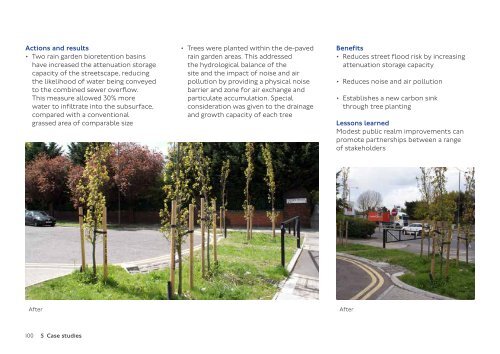SuDS in London - a guide
sustainable-urban-drainage-november-2016
sustainable-urban-drainage-november-2016
Create successful ePaper yourself
Turn your PDF publications into a flip-book with our unique Google optimized e-Paper software.
Actions and results<br />
• Two ra<strong>in</strong> garden bioretention bas<strong>in</strong>s<br />
have <strong>in</strong>creased the attenuation storage<br />
capacity of the streetscape, reduc<strong>in</strong>g<br />
the likelihood of water be<strong>in</strong>g conveyed<br />
to the comb<strong>in</strong>ed sewer overflow.<br />
This measure allowed 30% more<br />
water to <strong>in</strong>filtrate <strong>in</strong>to the subsurface,<br />
compared with a conventional<br />
grassed area of comparable size<br />
• Trees were planted with<strong>in</strong> the de-paved<br />
ra<strong>in</strong> garden areas. This addressed<br />
the hydrological balance of the<br />
site and the impact of noise and air<br />
pollution by provid<strong>in</strong>g a physical noise<br />
barrier and zone for air exchange and<br />
particulate accumulation. Special<br />
consideration was given to the dra<strong>in</strong>age<br />
and growth capacity of each tree<br />
Benefits<br />
• Reduces street flood risk by <strong>in</strong>creas<strong>in</strong>g<br />
attenuation storage capacity<br />
• Reduces noise and air pollution<br />
• Establishes a new carbon s<strong>in</strong>k<br />
through tree plant<strong>in</strong>g<br />
Lessons learned<br />
Modest public realm improvements can<br />
promote partnerships between a range<br />
of stakeholders<br />
After<br />
After<br />
100 5 Case studies


